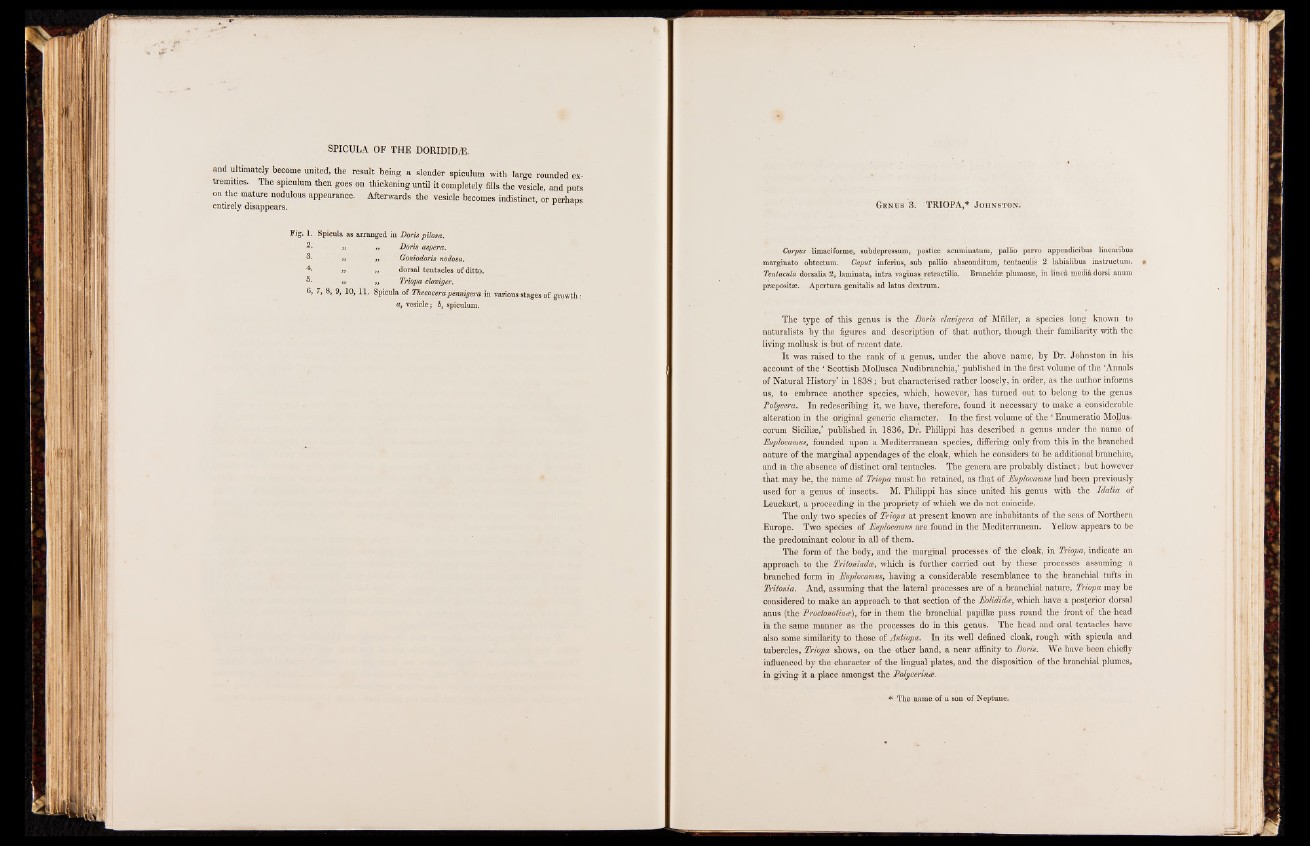
and ultimately become united, the result being a slender spiculum with large rounded extremities.
The spiculum then goes on thickening until it completely fills the vesicle, and puts
on the mature nodulous appearance. Afterwards the vesicle becomes indistinct, or perhaps
entirely disappears. r
Fig. 1. Spicula as arranged in Doris pilosa.
2. „ „ Doris aspera.
» ,, Goniodoris nodosa.
4* >, „ dorsal tentacles of ditto.
,, ,, Triopa claviger.
6, 7, 8, 9, 10, 11. Spicula of Thecacera pennigera in various stages of growth:
a, vesicle; b, spiculum.
Genus 3. TRIOPA,* J ohnston.
Corpus limaciforme, subdepressum, postice acuminatum, pallio parvo appendicibus linearibus
marginato obtectum. Caput inferius, sub pallio absconditum, tentaculis 2 labialibus instructum.
Tentacula dorsalia 2, laminata, intra vaginas retractilia, Branchiae plumosse, in lineä mediädorsi anum
praepositse. Apertura genitalis ad latus dextrum.
The type of this genus is the Doris claviger a, of Muller, a species vpmg known to
naturalists by the figures and description of that author, though their familiarity with the
living mollusk is but of recent date.
It was raised to the rank of a genus, under the above name, by Dr. Johnston in his
account of the ‘ Scottish Mollusca Nudibranchia,’ published in the first volume of the ‘Annals
of Natural History’ in 1838; but characterised rather loosely, in order, as the author informs
us, to embrace another species, which, however, has turned out to belong to the genus
Polycera. In redescribing it, we have, therefore, found it necessary to make a considerable
alteration in the original generic character. In the first volume of the ‘ Enumeratio Mollus-
corum Sicilise/ published in 1836, Dr. Philippi has described a genus under the name of
Phtplocamis, founded upon a Mediterranean species, differing only from this in the branched
nature of the marginal appendages of the cloak, which he considers to be additional branchiae,
and in the absence of distinct oral tentacles. The genera are probably distinct; but however
that may be, the name of Triojpa must be retained, as that of Euplocamus had been previously
used for a genus of insects. M. Philippi has since united his genus with the Idalia of
Leuckart, a proceeding in the propriety of which we do not coincide.
The only two species of Triopa at present known are inhabitants of the seas of Northern
Europe. Two species of JEuplocamus are found in the Mediterranean. Yellow appears to be
the predominant colour in all of them.
The form of the body, and the marginal processes of the cloak, in Triopa, indicate an
approach to the Tritoniad®, which is further carried out by these processes assuming a
branched form in Phtplocamus, having a considerable resemblance to the branchial tufts in
Tritonia. And, assuming that the lateral processes are of a branchial nature, Triopa may be
considered to make an approach to that section of the Eolidid®, which have a posterior dorsal
anus (the Proctonotin®), for in them the branchial papillae pass round the front of the head
in the same manner as the processes do in this genus. The head and oral tentacles have
also some similarity to those of Antiopa. In its well defined cloak, rough with spicula and
tubercles, Triopa shows, on the other hand, a near affinity to Doris. We have been chiefly
influenced by the character of the lingual plates, and the disposition of the branchial plumes,
in giving it a place amongst the Polycerin®.
* The name of a son of Neptune.